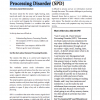Ann Acheson, Special Needs Consultant
You know about the five senses—sight, hearing, taste, touch and smell—but you may not be aware that most of us have two additional sensory systems that help us to control and integrate the information we gather. Sensory Processing Disorder is a condition that exists when sensory signals don’t get organized into appropriate responses by these systems.
In this tip sheet we will look at:
- Understanding Sensory Processing Disorder
- The symptoms of SPD in infants, toddlers and preschoolers
- What to do if you suspect a child has SPD
- Where to go for more information
Get the facts about Sensory Processing Disorder.
The systems that help us to control and integrate the information we gather through our five senses are called the vestibular and proprioceptive systems.
The vestibular system sends information about movement, gravity and balance from the inner ear to the brain. Together with the eyes, it regulates posture. This system supports behaviour regulation and prepares our muscles for movement.
The proprioceptive system gives us information from the muscles, tendons and joints about body position, weight, pressure, stretch, movement and changes of the body’s position in space. It plays a key role in effective motor planning.
SPD is a condition that exists when sensory signals don’t get organized into appropriate responses by the vestibular and proprioceptive systems. A child with SPD will find it difficult to process and act on information received through the senses. This creates challenges in performing countless everyday tasks.
Research shows that as many as 1 in 6 children may experience symptoms of SPD—which is often confused with Autism. The disorder can affect only one sense, or many of the senses, and symptoms may vary from time to time.
Learn the symptoms of SPD.
The following symptoms could indicate that a child has SPD.
Infant or Toddler
- Has problems eating or sleeping.
- Avoids food textures such as smooth or crunchy.
- Is irritable when being dressed; uncomfortable in clothing.
- Rarely plays with toys.
- Resists cuddling; arches away when held.
- Cannot calm self.
- Floppy or stiff body posture.
- Experiences delays in motor skill development.
Preschooler
- Is oversensitive to touch, noise, smells and some people.
- Has difficulty making friends; poor social skills.
- Has difficulty dressing, eating, sleeping and/or with toilet training.
- Is clumsy; has poor motor skills; is too weak or too strong.
- Is in constant motion; unaware of personal space of others.
- Has frequent or long tantrums.
If you suspect a child has SPD, speak up!
Early identification is extremely important for children with SPD, so if you suspect a child is having trouble processing sensory information, it’s important to speak up! If SPD isn’t treated effectively, it can lead to serious long-term problems such as behavioural difficulties, anxiety, depression, school failure and more.
A good place to start is by administering a screening tool and by talking about your concerns with a your CMAS consultant. The consultant can help you to determine if there is a need for referral to an early interventionist, occupational or physical therapist, speech and language pathologist or behaviour specialist. The consultant can also help you to investigate a child’s problem areas and to develop programming that addresses them.
Find out more about SPD.
The following resources can help you to learn more about SPD.
Websites:
www.sensory-processing-disorder.com
www.sinetwork.org/about-sensory-processing-disorder.html
www.spdcanada.org
www.SPDFoundation.net
Books:
Out of Sync Child & Out of Sync Child has Fun, by Carol Kranowitz
101 Activities for Kids in Tight Spaces, by Carol Kranowitz
Building Bridges through Sensory Integration, by Ellen Yack B.Sc., M.Ed., O.T., Paula Aquilla B.Sc., O.T, and Shirley Sutton B.Sc., O.T.
Sensory Integration and the Child, by Jean Ayres







